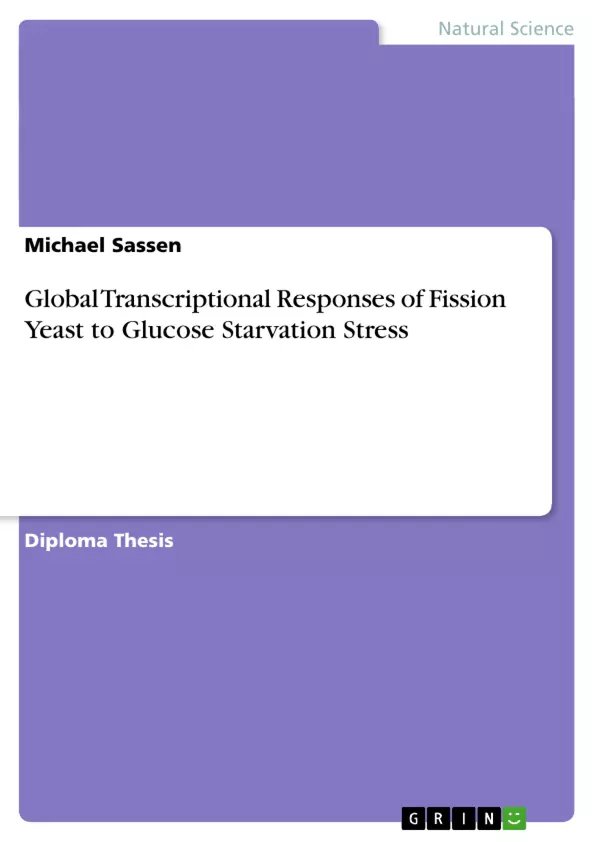1. Introduction
1.1 Schizosaccharomyces pombe as a Model System
S. pombe functions as a suitable model system since it is easy and inexpensive to rear, has a convenient size, a short life cycle, and is genetically manipulable. As a unicellular eukaryote, the fission yeast S. pombe can exist either in a haploid or diploid state and possesses two different mating types (h+ and h-). The wild type, however, is h90, which means it can switch mating type.
Figure 1.01: Left, picture of S. pombe cells
At top are two dividing cells in late mitotic phase, showing the fission yeast typical septum at the point of cytoplasmic division. The lower cell is in early M phase, having its chromosomes already segregated.
Figure 1.02: Right, fission yeast cell cycle
Diagrammatic representation of the S. pombe cell cycles with the interchange between the two occurring in G1 phase (Figure obtained and used with permission from Trevor Pemberton, University of Sussex).
[...]
S. pombe can undergo two different life cycles, either the vegetative (mitotic) cycle or the sporulation (meiotic) cycle, depending on the environment it is living in. These two cycles are shown in figure 2 with the change between the two occurring in cells at the G1 stage of the mitotic cycle. Under laboratory conditions, given all nutrients required, S. pombe prefers the haploid state. This makes it a favorable organism for genetic research since it ensures that introduced mutations are not masked by another wild type allele. [...]
Inhaltsverzeichnis (Table of Contents)
- Introduction
- Schizosaccharomyces pombe as a Model System
- Why Investigating Signaling Cascades?
- The SAPK Pathway
- The cAMP Pathway
- The Pheromone Pathway
- Downstream the PKA and SAPK pathways
- Transporters in Fission and Budding Yeast
- Glycolysis, Gluconeogenesis and Glycerol Metabolism
- Microarrays
- Thesis Goal
- Materials
- Sources of Used Chemicals, Enzymes, and Kits
- S. pombe Strains
- Solutions and Yeast Media
- Equipment
- Methods
- Experimental Design
- Growth of S. pombe Strains
- Harvesting Cells
- RNA Extraction
- Sample Preparation
- Microarray
- Results
- Genes Up-Regulated upon Glucose Starvation
- Highly Induced Genes of the Carbohydrate Metabolism
- Genes Involved in Mating/Meiosis
- Genes Involved in Global Transcriptional Regulation
- Hexose Transporters
- CAMP, SAPK, Pheromone Pathway Genes
- Glucose Starvation vs. Oxidative Stress
- Glucose starvation vs. Nitrogen starvation
- Down-Regulated Processes
- How does Gene Expression Change in a spc1 Deletion Mutant?
- PombePerl
- Discussion
- Changes in Metabolic Pathways
- Stress Activated Signaling Pathways
- Changes of a Cell's Global Processes
- Effects of a spcl Deletion on Signaling Pathways
- Summary and Outlook
Zielsetzung und Themenschwerpunkte (Objectives and Key Themes)
The main objective of this thesis is to examine the global transcriptional response of the fission yeast Schizosaccharomyces pombe to glucose starvation stress. By utilizing microarray technology and analyzing the expression profiles of genes involved in various pathways, the author aims to shed light on the molecular mechanisms employed by fission yeast to adapt to this stressful condition.
- The role of signaling cascades in mediating the cellular response to glucose starvation.
- The specific genes and pathways that are up-regulated and down-regulated upon glucose deprivation.
- The functional significance of these transcriptional changes in relation to metabolic adaptation, stress tolerance, and cell cycle control.
- The comparison of the glucose starvation response to other environmental stresses, such as oxidative stress and nitrogen starvation.
- The impact of specific gene deletions on the signaling pathways involved in the glucose starvation response.
Zusammenfassung der Kapitel (Chapter Summaries)
The first chapter provides an introduction to Schizosaccharomyces pombe as a model organism for studying cellular processes, particularly in response to stress. It delves into the importance of investigating signaling cascades, focusing on the SAPK, cAMP, and pheromone pathways. The chapter concludes with a discussion of microarray technology and the thesis's goal.
Chapter 2 describes the materials used in the study, including chemical sources, yeast strains, solutions, media, and equipment.
Chapter 3 outlines the experimental design and methods employed, encompassing cell growth, harvesting, RNA extraction, sample preparation, and microarray analysis.
Chapter 4 presents the results of the microarray analysis, highlighting genes up-regulated upon glucose starvation, those involved in carbohydrate metabolism, mating/meiosis, global transcriptional regulation, hexose transport, the cAMP, SAPK, and pheromone pathways, as well as the comparison of glucose starvation response to other stress conditions and the impact of specific gene deletions.
Chapter 5 delves into the discussion of the results, focusing on changes in metabolic pathways, stress-activated signaling pathways, the overall impact on cellular processes, and the effects of specific gene deletions on signaling pathways. The chapter concludes with a summary and outlook for future research.
Schlüsselwörter (Keywords)
The main keywords and focus topics of this work include: Schizosaccharomyces pombe, glucose starvation, global transcriptional response, microarray analysis, signaling cascades, stress adaptation, metabolic pathways, gene regulation, cell cycle control, SAPK pathway, cAMP pathway, pheromone pathway, oxidative stress, nitrogen starvation, gene deletions.
- Quote paper
- Michael Sassen (Author), 2005, Global Transcriptional Responses of Fission Yeast to Glucose Starvation Stress, Munich, GRIN Verlag, https://www.grin.com/document/41887



